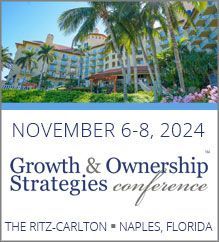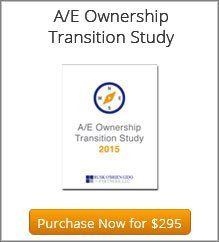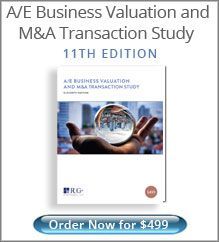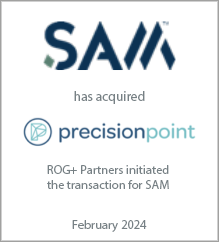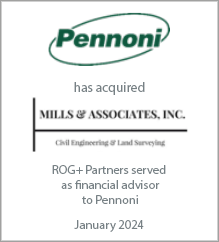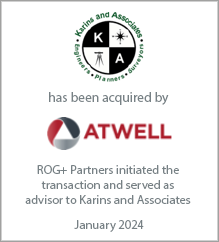Steve Gido specializes in corporate financial advisory services with a focus on mergers and acquisitions. Steve has assisted architecture, engineering, environmental consulting and construction firms of all sizes across North America achieve their growth or liquidity goals through successful mergers & acquisitions. Steve has over 15 years of investment banking experience and holds the chartered financial analyst (CFA) designation from the CFA Institute.
But Who’s Going to Buy ME Out? Three Paths for A/E Owners
But Who’s Going to Buy ME Out? Three Paths for A/E Owners
April 8, 2019
Earlier this year I met with the senior leadership team at an 85-person multi-discipline engineering firm in the southeast. Coming off the best year in company history, the group felt proud of their financial success and client accomplishments and, with the possibility of a few big projects breaking their way, felt 2019 could be even better. The nine owners present were between 45 and 65 years old and had a good sense of their collective mission, culture, and values. Unfortunately, not everyone was on the same page regarding which course they should take with their ownership evolution, so I was there to help assess various strategic alternatives with them.
Underlying our discussion was a feeling that while prospects for our industry and economy were still generally upbeat, there was the reality we could also be at a mature cycle stage. As such, for some, particularly the older shareholders who have seen the ups and downs of industry waves play out over 40 years, the timing felt “right” to capture this value and implement a formal transaction. The goal was to also bring a structure of long-term sustainability and survivability for their people and clients. As with most A/E firms considering similar scenarios and challenges, there were three viable options for them.
Underlying our discussion was a feeling that while prospects for our industry and economy were still generally upbeat, there was the reality we could also be at a mature cycle stage. As such, for some, particularly the older shareholders who have seen the ups and downs of industry waves play out over 40 years, the timing felt “right” to capture this value and implement a formal transaction. The goal was to also bring a structure of long-term sustainability and survivability for their people and clients. As with most A/E firms considering similar scenarios and challenges, there were three viable options for them.
1. Traditional Internal Transition–
For the vast majority of A/E and environmental consulting firms the internal transition remains the most common form of ownership transfer. Like those at accounting and law firms, senior management cultivates the next generation of leaders and managers and subsequently sells blocks of stock to them in a coordinated manner over many years. This struck a chord with several individuals at the meeting, particularly the younger leaders coming into their own, who enjoyed their independence and possessed a desire to perpetuate the firm’s legacy. They saw minimal disruption with their clients and staff under this approach.
Fortunately, many A/E firms today are doing quite well, and growing, profitable organizations with little debt and strong cash flow can serve as a great mechanism for internal transfer programs. In fact, there are many creative ways to implement these transactions, from the company itself redeeming shares, to direct buyouts and installment notes between individuals, to hybrid deferred compensation models that could balance the needs of both buyers and sellers.
Others in the room acknowledged the need for price affordability but believed this plan would generate the lowest value to the senior shareholders who felt they were most responsible for the firm’s recent success. In addition, while the firm was on solid footing today, the prospect of assuming sizable shareholder redemption liabilities left some wary as well as taking over seven years to get fully bought out! There was a realization that the company would have to serve as a financing conduit, either through raises, loans and/or bonuses, to the next generation, potentially leaving fewer funds available for other growth pursuits and incentives.
2. Employee Stock Ownership Plan (ESOP)– Some were intrigued with implementing an ESOP, which is basically a form of qualified retirement savings plan. In fact, hundreds of A/E and environmental consulting firms have them as both an ownership transition tool and employee benefit. ESOPs are often implemented to provide a market for the shares of senior owners who have sizable concentrations of shares, to incentivize and reward all employees (ESOPs are non-discriminatory plans), and for the firm to establish a trust to make tax-deductible cash contributions or borrow money at a lower after-tax cost. Generally, we see companies around $10 million and above in revenue as the right size to pursue an ESOP, so this firm was a good candidate.
While some of the owners agreed with the powerful tax benefits and a likely higher valuation than the straight internal ownership approach, others noted the higher upfront costs of implementing it as well as a possible dilution to the remaining shareholders. And while having an ESOP doesn’t mean that other motivational arrangements like incentive compensation or stock appreciation rights go away, some felt it would be overly complicated to administer and that “there’s no going back” once it’s put in place. Some saw it fitting right in with their culture and others weren’t so sure.
It seemed there were strong opinions one way or the other on ESOPs, as many had friends at competitors using them with varying levels of satisfaction and motivational effect.
3. External Firm Sale– The final option we tackled was perhaps selling the company outright to a larger buyer. All saw the ramifications of a consolidating A/E industry with growth-oriented companies snapping up others and taking root in their region. For all their success, this firm frequently felt squeezed between those national behemoth and super-regional engineering firms with deeper marketing, recruiting and financial resources and the small, local boutiques with lower fees and focused service or market niches.
The younger owners seemed most resistant to selling but recognized it would most definitely yield the highest valuation and quickest liquidity for everyone. The entire group shared war stories of familiar deals that seemed to succeed and others that didn’t. Professional services combinations can be fragile and integrating two disparate firms with different cultures, operations, processes, clients and egos, even with the best of intentions and expectations, are fraught with risk. Some realized the thorny challenge to make the transition from entrepreneur/owner to employee in a large firm, giving up control and “having to work for someone else.”
However, the consensus among them was that they might not have the number of interested and motivated next generation of engineers and planners to make an internal transition work. While their staff in their 20s and 30s were bright, capable and eager, there was a lingering worry, whether real or perceived, that they did not have an intense desire or aptitude to become owners. Despite the compelling argument that the rate of return (stock price appreciation plus annual dividends) has proven to be a strong investment for this team of senior owners, all saw a younger group as overburdened with college debt, a zeal for “work-life balance” first, and risk-averse to their career and ownership pursuits.
Fortunately, many A/E firms today are doing quite well, and growing, profitable organizations with little debt and strong cash flow can serve as a great mechanism for internal transfer programs. In fact, there are many creative ways to implement these transactions, from the company itself redeeming shares, to direct buyouts and installment notes between individuals, to hybrid deferred compensation models that could balance the needs of both buyers and sellers.
Others in the room acknowledged the need for price affordability but believed this plan would generate the lowest value to the senior shareholders who felt they were most responsible for the firm’s recent success. In addition, while the firm was on solid footing today, the prospect of assuming sizable shareholder redemption liabilities left some wary as well as taking over seven years to get fully bought out! There was a realization that the company would have to serve as a financing conduit, either through raises, loans and/or bonuses, to the next generation, potentially leaving fewer funds available for other growth pursuits and incentives.
2. Employee Stock Ownership Plan (ESOP)– Some were intrigued with implementing an ESOP, which is basically a form of qualified retirement savings plan. In fact, hundreds of A/E and environmental consulting firms have them as both an ownership transition tool and employee benefit. ESOPs are often implemented to provide a market for the shares of senior owners who have sizable concentrations of shares, to incentivize and reward all employees (ESOPs are non-discriminatory plans), and for the firm to establish a trust to make tax-deductible cash contributions or borrow money at a lower after-tax cost. Generally, we see companies around $10 million and above in revenue as the right size to pursue an ESOP, so this firm was a good candidate.
While some of the owners agreed with the powerful tax benefits and a likely higher valuation than the straight internal ownership approach, others noted the higher upfront costs of implementing it as well as a possible dilution to the remaining shareholders. And while having an ESOP doesn’t mean that other motivational arrangements like incentive compensation or stock appreciation rights go away, some felt it would be overly complicated to administer and that “there’s no going back” once it’s put in place. Some saw it fitting right in with their culture and others weren’t so sure.
It seemed there were strong opinions one way or the other on ESOPs, as many had friends at competitors using them with varying levels of satisfaction and motivational effect.
3. External Firm Sale– The final option we tackled was perhaps selling the company outright to a larger buyer. All saw the ramifications of a consolidating A/E industry with growth-oriented companies snapping up others and taking root in their region. For all their success, this firm frequently felt squeezed between those national behemoth and super-regional engineering firms with deeper marketing, recruiting and financial resources and the small, local boutiques with lower fees and focused service or market niches.
The younger owners seemed most resistant to selling but recognized it would most definitely yield the highest valuation and quickest liquidity for everyone. The entire group shared war stories of familiar deals that seemed to succeed and others that didn’t. Professional services combinations can be fragile and integrating two disparate firms with different cultures, operations, processes, clients and egos, even with the best of intentions and expectations, are fraught with risk. Some realized the thorny challenge to make the transition from entrepreneur/owner to employee in a large firm, giving up control and “having to work for someone else.”
However, the consensus among them was that they might not have the number of interested and motivated next generation of engineers and planners to make an internal transition work. While their staff in their 20s and 30s were bright, capable and eager, there was a lingering worry, whether real or perceived, that they did not have an intense desire or aptitude to become owners. Despite the compelling argument that the rate of return (stock price appreciation plus annual dividends) has proven to be a strong investment for this team of senior owners, all saw a younger group as overburdened with college debt, a zeal for “work-life balance” first, and risk-averse to their career and ownership pursuits.
Which path is the best? Obviously, not an easy decision among a group of veteran practitioners with similar, but varied timing and personal goals. And all of these options need to be carefully balanced with each shareholder’s specific tax, wealth/estate, and professional goals and situation. Many A/E owners don’t start a company with the endgame in mind, but better to be in control of your own firm’s destiny than leave it up to chance.
ROG + Partners is the only financial advisory services firm dedicated to the A/E and environmental consulting industry that offers trusted advice and experience with each of the paths described above. Whether you are seeking a valuation or evaluating your firm’s strategic and ownership alternatives, please contact us as to how we can help your organization.
Our one-day Ownership Transition Strategies Seminar scheduled for the Four Seasons Hotel in St Louis on May 8th will detail the options owners have in developing a plan that is sustainable for A/E firm owners. Click here for more details or give me a call.
ROG + Partners is the only financial advisory services firm dedicated to the A/E and environmental consulting industry that offers trusted advice and experience with each of the paths described above. Whether you are seeking a valuation or evaluating your firm’s strategic and ownership alternatives, please contact us as to how we can help your organization.
Our one-day Ownership Transition Strategies Seminar scheduled for the Four Seasons Hotel in St Louis on May 8th will detail the options owners have in developing a plan that is sustainable for A/E firm owners. Click here for more details or give me a call.
Latest Perspective
Perfecting the A/E Exit Strategy – Five Key Factors
An enormous A/E generation that kicked off their careers in the 1980s and subsequently started firms or became owners in the 1990s ...
© 2024
Rusk O'Brien Gido + Partners, LLC
Financial Experts for Architects, Engineers, and Environmental Consulting Firms


